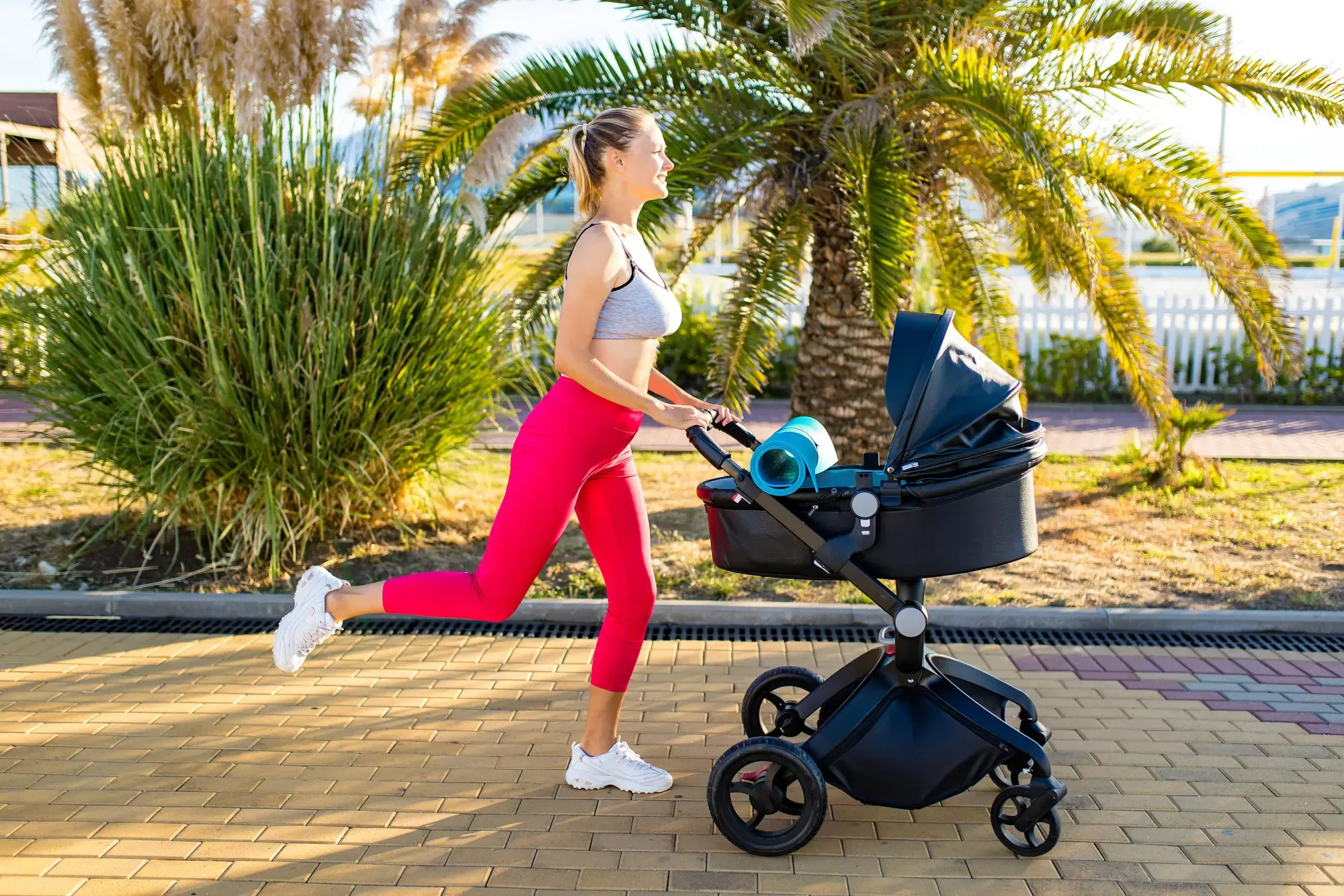Having a baby is without a doubt life-changing. While the delight of finally having that little bundle of joy is unparalleled, pregnancy and childbirth can significantly change the body. Patients may start to wonder how they are going to get back to their pre-pregnancy fitness level, and when they can start running again.
And that’s normal! Because running is beneficial for health and it’s also a great way for parents to find some self-care time in the midst of this big change. With that being said, it’s vital to have a plan in order to return to running safely and with care.
To get the right advice on getting back to running after a baby, our exercise physical therapists at Ironhorse Physical Therapy & Pilates have women’s health knowledge and experience to support patients in San Ramon, CA.
What Happens To The Body After Pregnancy?
There are a lot of changes that unavoidably occur in the body during pregnancy, particularly in the later stages of being pregnant.
Physical therapy is a great way for patients to learn about these changes, which can determine when it’s safe to start running after giving birth. Starting with the pelvic floor.
What Happens To The Pelvic Floor After Birth?
The pelvic floor is a hammock-like sling of small muscles in the pelvis that support the pelvic organs during pregnancy. The birthing process can be traumatic for the pelvic floor muscles, and they may even rip during delivery.
As a result, it takes time for the pelvic floor muscles to recover after childbirth. Some women may require stitches, or in some cases surgery, to repair the muscles. Women’s health physical therapists see this everyday and can support women to regain the control of their pelvic floor muscles.
This is a vital step in readiness to return to running and other fitness activities which can load the pelvic floor muscles. If the muscles aren’t ready, it can lead to pain, discomfort, and incontinence.
The Position Of Organs
Certain organs in the belly that sit around the uterus may shift in order to accommodate the growing baby. For example, when the uterus expands, other organs like the stomach and the intestines move to make room for the developing fetus.
These changes are completely normal and are in fact vital for the health of the little one as it gets bigger and develops. And the positioning of these organs does not immediately reverse right after birth, but can take quite a while.
Although it can be frustrating, this is why a systematic plan is needed for returning to high-impact activities like running.
The Uterus Size
After birth, the body gradually settles back towards how it was before the pregnancy. This includes the uterus which expanded throughout the pregnancy, particularly in the final trimester. Once the baby is born, the uterus contracts back until it becomes more like its pre-pregnancy size.
This doesn’t happen overnight and requires a bit of patience.
Muscle Strength
At the same time, the abdominal muscles also need time to recover, especially the rectus abdominis which is heavily impacted by childbirth and pregnancy. These muscles stretch during pregnancy to accommodate the baby growing.
Recovering strength in the tummy muscles after birth is a gradual process. But it’s a crucial one because these muscles are heavily involved in core stability.
The Joints And Ligaments
Another notable change in the body during pregnancy is something called joint laxity. This is when the ligaments become more pliable, mainly due to a hormone called relaxin. This hormone has a role in preparing the body for childbirth.
It means the joints have more room to move, an important change to help when the baby is pushed through the birthing canal during delivery.
Although this hormone is essential for widening the pelvis for childbirth, it can also make the joints and ligaments more susceptible for injury in the postpartum period. It’s important to find a physical therapist who understands the effect of these changes and approaches any post-partum exercise with care.
Should You See A Doctor Before Returning To Running?
Some patients may feel nervous to get back into running after giving birth. Seeing a doctor is a great way to get reassurance as they can assess the pregnancy, birth, and overall health to assess when it’s ok to resume running.
But this isn’t just a box to tick. Rather, it’s an essential step for the health of the body and ensuring things go smoothly and safely. This step can help patients avoid any complications from running too early.
Doctors can also give advice on when to start physical therapy.
When To Get Back To Running In The Postpartum Period
There are different stages to go through in the postpartum period to get back to running. This is because there are so many changes that happen throughout pregnancy and childbirth. These changes are based on circumstances like how the baby was delivered and the speed of recovery afterwards.
For most patients, it can take weeks and months, or even longer, to fully recover from the process and feel ready to run again. Patients should be patient when it comes to running after giving birth. It’s essential to put a rehabilitation plan in place in order to help the body adjust to the changes.
Physical Therapy For Returning To Running
Physical therapists are equipped with tools like exercise, massage, dry needling, passive modalities, and more, to help patients get back to running safely after giving birth. They can also provide advice and education on the different stages of getting back to running and what happens in each one.
1. Healing
In the first days and weeks after childbirth, the body needs time to deal. This means focusing on resting and recovering, and running is usually the last thing on patients’ minds.
Short walks or gentle stretching may be helpful but challenging activities like running are off the table. This can just put too much stress on a vulnerable body. As the body has just undergone the trauma of childbirth, patients should give their body the time it needs to heal.
2. Gentle Return To Exercise
To ensure everything is progressing well, patients are closely followed up by their medical support team. There are two phases after the immediate recovery period and it’s important to follow healthcare advice.
After one or two weeks, the body is still adjusting to the changes following childbirth. It’s normal for patients to experience some discomfort or bleeding in the area (although this can depend on whether they had a vaginal or surgical birth). Patients take solace in the fact the body continues to regain its strength.
However, changes are incremental. Progress in the subsequent three to six weeks can be slow, but it’s an important period of time which can be used to outline any goals for returning to running postpartum and get guidance on when to start. Postpartum check-ups continue to assess overall health and wellbeing.
Physical therapy advice usually involves gentle walks only as the body still needs these weeks for time to heal.
3. Low-Impact Exercise
Beyond six weeks, the timeframe for starting running can vary greatly from patient to patient. While some patients may feel ready to resume running at six weeks postpartum – after clearance from the doctor – others may still not be running at twelve weeks.
Most patients will need time between six to twelve weeks to adjust to exercise. For these patients who aren’t ready for running, physical therapy can be hugely beneficial. They can invest time focusing on things like restoration and core stability through low-impact exercise. At Orleans, our physical therapists often suggest opting for other low-impact workouts like gentle Pilates exercises or other similar movements.
This form of exercise can help support the recovery of muscles, such as the abdominals and the pelvic floor, whilst also preparing the body to start running eventually.
4. Running And Beyond
The recovery timeline after pregnancy looks different for everyone. It’s guided by how the body responds and the advice of doctors.
After twelve weeks postpartum and beyond, some patients might be happily running. Physical therapy is still important to ensure the muscles are recovering properly and to integrate cross-training.
For patients at the six-month mark who still haven’t started running, there is no need to rush. There are plenty of alternatives. These can include low-impact exercises such as swimming, yoga, Pilates, or cycling, all of which can help rebuild strength and function.
If you want to start running again after giving birth, consult our physical therapists for Running Gait Analysis in San Ramon.
Finding Your Running Groove After Having A Baby
Running again after giving birth is not a one-size-fits-all situation and there are multiple stages to navigate through. Guidance from a skilled physical therapist can be invaluable.
For women’s health physical therapy in San Ramon, CA, get in touch with our experienced team at Ironhorse Physical Therapy & Pilates. We are here to help our patients every step of the way towards running again postpartum.


